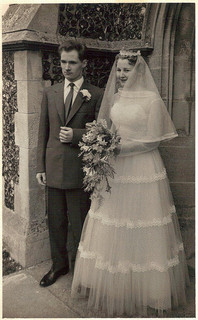 Leonard and Mary lived together for 50 years, 7 months and 3 days of wedded bliss. Mary sometimes jokingly told the ladies in her quilting group that it was 40 years of bliss preceded by 10 years of training Lenny (as only she called him). That line always brought winks and knowing comments. But everyone who knew this pair could see the love and joy that permeated every moment. They were seldom apart.
Leonard and Mary lived together for 50 years, 7 months and 3 days of wedded bliss. Mary sometimes jokingly told the ladies in her quilting group that it was 40 years of bliss preceded by 10 years of training Lenny (as only she called him). That line always brought winks and knowing comments. But everyone who knew this pair could see the love and joy that permeated every moment. They were seldom apart.
They raised a flock of good kids on their mid-west dairy farm (“The Home Place”). Despite what Leonard and Mary hoped, all the kids moved off after they married. The kids created more urban and “successful” lives for themselves.
Leonard and Mary adjusted as they always did to the hard patches. They lived the life they were given. They were active in their community (which was fading) and their local church (which was fading as well). They relished the opportunity God gave them to share their blessings (everything was paid for and their kids were doing great on their own so money was never a problem).
They loved it when the kids and “grands” came for the holidays or for summer “Grands’ Camp.” The rambling old farm house echoed with the thump of kids, giggles and the hum of conversation for fewer and fewer hours each year.
When things ended, Mary was sponsoring 21 children on 4 continents. She had a bulletin board in the mud room that featured a National Geographic world map with yarn and pins showing the location of each child whose photo was tacked around the edges of the board. Notes and letters were pinned in stacks around border as well. On the far right was a list of every child’s birthday.
Mary (and Leonard who had learned to follow her “suggestions”) were consistent tithers at church and to the ministries they loved — ones they knew were changing the world. They rescued women in California from sex trafficking and built radio towers in Asia with their gifts. Through their giving they fed people on the streets of 6 cities and built more than a few buildings.
They were always tickled (and amazed) when they came to the end of a year and discovered just how much had been accomplished by those they supported.
And then one cold clear February morning, Leonard brought coffee up to Mary, as he had for decades and found that she’d died after he’d left their bed to do the milking. She died peacefully in her sleep, hair a bit mussed but with the sweetest smile on her face.
Leonard’s by himself now. He’s let all the ministries and organizations know about Mary’s passing. And he’s making do in an empty farmhouse with an emptier life.
So when Leonard wrote on a response device a few months ago that Mary was deceased, what did your gift-processing person do?
As one of the ministries that Leonard and Mary loved, did you respond?
Or are you still sending mail to “Leonard and Mary”?
Do your wonderfully strategic newsletters still insert salutations into the letter copy to “Leonard and Mary”?
And how satisfied will Leonard feel when he calls again and he’s told that it takes several months for donor data to be updated?
Your ministry or charity will prosper or struggle based on how seriously you take your donor data.
It isn’t data.
It’s a relationship.
What do you think? Know any situations like I describe? What ticks you off about bad data? (One organization has decided that I’m “Stephen” . . . ummm . . . not in a hurry to give to that kind of sloppy relationship management.) I’d love to know what you think about donorbase-managed relationships.
![]()
Steve Thomas
Partner, Oneicity
(photo credit: Fimb)

2 thoughts on “live by your donor database or die by it”
Terrific story. Powerful point. I love it when I’m fully engaged with a story and get hit with a surprise. Well done (told, written)!
Thank you for your kind words Deb!
Comments are closed.